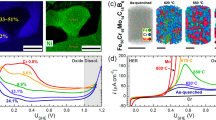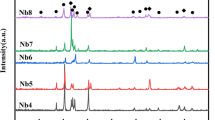Abstract
A one-to-one correspondence is developed between the phase stability and corrosion resistance of the commercial (Ni-Cr-Mo)-based alloys C-276 and C-4. Alloy C-4 is shown to outperform alloy C-276 in acidic oxidizing media and approaches its resistance in acidic reducing media. Both alloys are found to have similar resistance to chloride-induced stress corrosion cracking in the annealed condition with short-range order. The aqueous corrosion resistance of both alloys is found to be improved by long-range order; however, they become highly susceptible to chloride-induced stress corrosion cracking. Alloy C-4 is distinguished by being stable toward precipitation of detrimental intermetallic compounds. However, alloy C-276 is shown to be prone to precipitation of mu phase which degrades its resistance to aqueous corrosion and chloride-induced stress corrosion cracking. It is concluded that the chemical composition of alloy C-4 is tailored to make it more versatile than alloy C-276 in acidic oxidizing media and the results are found to be consistent with the concept of atomic percent factor of each alloy.













Similar content being viewed by others
References
P. Crook, Corrosion Characteristics of the Wrought Ni-Cr-Mo Alloys, Mater. Corros., 2005, 56, p 606–610
V. Burt, Corrosion in the Petrochemical Industry, 2nd ed., ASM International, Materials Park, 2015, p 75–81
P. Crook, Corrosion-Resistant Nickel Alloys: Part II, Adv. Mater. Process., 2007, 56, p 31–33
D.C. Agarwal and W.R. Herda, The “C” Family of Ni-Cr-Mo Alloys’ Partnership with the Chemical Process Industry: The Last 70 Years, Mater. Corros., 1997, 48, p 542–548
H. Shi, Z. Gao, Z. Fan, and Y. Ding, Corrosion Behavior of Alloy C-276 in Supercritical Water, Adv. Mater. Sci. Eng., 2018, 2018, art. no. 1027640
S. Lee, M.J. Kim, J. Park, S.Y. Hwang, S.W. Chung, S.J. Lee, and Y. Yun, Corrosion Behavior of Hastelloy (R) C-4 (R) Ni-Cr-Mo-Fe Alloys for Coal Gasification Syngas Plants, Mater. Test., 2018, 60, p 156–162
C.C. Sequeira, D.S.P. Cardoso, L. Amaral, B. Sljukic, and D.M.F. Santos, On the Performance of Commercially Available Corrosion-Resistant Nickel Alloys: A Review, Corros. Rev., 2016, 34, p 187–200
A. Mishra, Performance of Corrosion-Resistant Alloys in Concentrated Acids, Acta Metall. Sin. (Engl. Lett.), 2017, 30, p 306–318
A.N. Arjomand, I. Petrushina, A. Nikiforov, J.O. Jensen, and M. Rokni, Corrosion Behavior of Construction Materials for Ionic Liquid Hydrogen Compressor, Int. J. Hydrogen Energy, 2016, 41, p 16688–16695
X. Tang, S. Wang, L.L. Qian, Y.H. Li, Z.H. Lin, D.H. Xu, and Y.P. Zhang, Corrosion Behavior of Nickel Base Alloys, Stainless Steel and Titanium Alloy in Supercritical Water Containing Chloride, Phosphate and Oxygen, Chem. Eng. Res. Des., 2015, 100, p 530–541
C.M. Giordano, M.R. Ortiz, M.A. Rodriguez, R.M. Carranza, and R.B. Rebak, Crevice Corrosion Testing Methods for Measuring Repassivation Potential of Alloy C-22, Corros. Eng. Sci. Technol., 2011, 46, p 129–133
N.S. Zadorozne, M.A. Rodriguez, R.M. Carranza, Corrosion resistance of Ni-Cr-Mo and Ni-Mo-Cr alloys in different metallurgical conditions. NACE corrosion 2010, paper no. 10236
Q. Zhang, R. Tang, K.J. Yin, X. Luo, and L.F. Zhang, Corrosion Behavior of Hastelloy C-276 in Supercritical Water, Corros. Sci., 2009, 51, p 2092–2097
A.C. Lloyd, J.J. Noel, S. McIntyre, and D.W. Shoesmith, Cr, Mo and W Alloying Additions in Ni and Their Effect on Passivity, Electrochem. Acta, 2004, 49, p 3015–3027
K.S.E. Al-Malahy and T. Hodgkiess, Comparative Studies of Seawater Corrosion Behavior of a Range of Materials, Desalination, 2003, 158, p 35–42
H.M. Tawancy, On the Precipitation of Intermetallic Compounds in Selected Solid-Solution Strengthened Ni-Base Alloys and Their Effects on Mechanical Properties, Metallogr. Microstruct. Anal., 2015, 6, p 200–215
K. Chandra, A. Mahanti, V. Kain, B.S. Kumar, N. Kumar, and V. Gautam, Failure Cases Related to Materials Issue in Wet-Process Phosphoric Acid Plant, Eng. Fail. Anal., 2017, 79, p 642–655
H.M. Shalaby, Failure of Hastelloy C-276 Pump Impeller in Hydrochloric Acid, Eng. Fail. Anal., 2008, 15, p 543–546
R.C. Yin, Y. Al-Bakheet, and A.H. Al-Shawaf, Failure Analysis of an EDC Incinerator Quench Nozzle, Eng. Fail. Anal., 2007, 14, p 41–46
Haynes international heat treatment brochure. http://www.haynesintl.com/alloys/fabrication-brochure/heat-treatment
Annual Book of ASTM Standards, vol. 3.02, G 28A, G28 B, G 31 (ASTM International, Conshohocken, 2001).
M.G. Fontana and N.G. Greene, Corrosion Engineering, McGraw-Hill, New York, 1978, p 116–156
ASTM G36-94, Standard Practice for Evaluating Stress-Corrosion Cracking Resistance of Metals and Alloys in a Boiling Magnesium Chloride Solution, ASTM International Conshohocken, Pennsylvania, 2013
H.M. Tawancy, Correlation Between Disorder-Order Transformations in a Ni-Based Alloy and its Mechanical Properties, Mater. Sci. Eng. A, 2018, 719, p 93–103
D.L. Douglass, G. Thomas, and W.E. Roser, Ordering, Stacking Faults and Stress Corrosion Cracking in Austenitic Alloys, Corrosion, 1964, 20, p 15t–28t
G. Thomas, The Effect of Short-Range Order on Stacking Fault Energy and Dislocation Arrangements in fcc Solid Solutions, Acta Met., 1963, 11, p 1369–1371
P.R. Swann, Dislocation Substructure vs. Transgranular Stress Corrosion Susceptibility of Single Phase Alloys, Corrosion, 1963, 19, p 102t–114t
P.R. Swann, Dislocation arrangements in face-centered cubic metals and alloys, Electron Microscopy and Strength of Crystals, G. Thomas and J. Washburn, Ed., Wiley Interscience, New York, 1963, p 131–181
C.L. Zacherl, S.L. Shang, D.E. Kim, Y. Wang, and Z.K. Liu, Effects of alloying elements on elastic, stacking fault and diffusion properties of FCC Ni from first-principles: implications for tailoring the creep rate of Ni-base superalloys, Superalloys 2012: 12th International Symposium on Superalloys, E.S. Huron, R.C. Reed, M.C. Hardy, M.J. Mills, R.E. Montero, P.D. Portella, and J. Telesman, Ed., The Minerals, Metals and Materials Society, Warrendale, 2012, p 455–461
H.M. Tawancy and M.O. Aboelfotoh, Application of Long-Range Ordering in the Synthesis of Nanoscale Ni2(Cr, Mo) Superlattice with High Strength and High Ductility, Mater. Sci. Eng. A, 2009, 500, p 188–195
D. Nguyen-Manh, V. Vitek, and A.P. Horsfeld, Environmental Dependence of Bonding: A Challenge for Modeling of Intermetallics and Fusion Materials, Prog. Meter. Sci., 2007, 52, p 255–298
A. Asphahani, P.E. Manning, and J. Straatmann, New Advances in Molybdenum-Containing Corrosion Resistant Alloys, Molybd. Moasic, 1987, 10, p 1–5
N. Sridhar, J.B.C. Wu, and P.E. Manning, Corrosion Resistant Ni-Cr-Mo Alloys, J. Met., 1985, 37, p 51–53
Acknowledgments
It is a pleasure to acknowledge the continued support of King Fahd University of Petroleum and Minerals.
Author information
Authors and Affiliations
Corresponding author
Additional information
Publisher's Note
Springer Nature remains neutral with regard to jurisdictional claims in published maps and institutional affiliations.
Rights and permissions
About this article
Cite this article
Tawancy, H.M., Alhems, L.M. Comparison of the Phase Stability and Corrosion Resistance of the Ni-Based Alloys C-4 and C-276. J. of Materi Eng and Perform 28, 2489–2498 (2019). https://doi.org/10.1007/s11665-019-04031-0
Received:
Revised:
Published:
Issue Date:
DOI: https://doi.org/10.1007/s11665-019-04031-0




